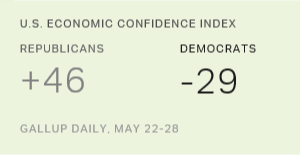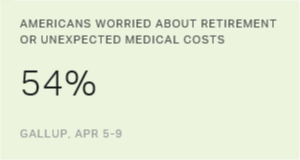Story Highlights
- Election, inauguration altered partisans' views of U.S. economy
- Republican confidence largely showed immediate effects of events
- Changes in Democratic confidence have been more gradual
WASHINGTON, D.C. -- Republicans' and Democrats' confidence in the economy changed greatly immediately after Donald Trump's election and inauguration. However, Republicans' confidence has changed little since the inauguration in late January, while Democrats' has continued to worsen.
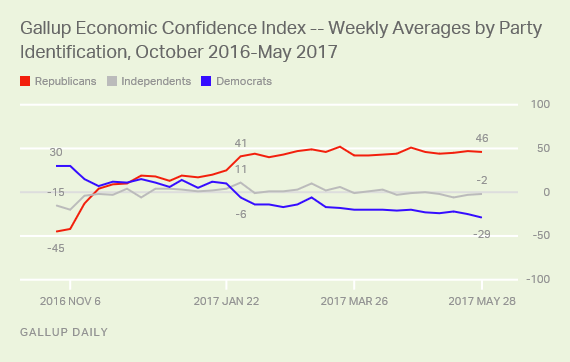
These findings are based on weekly averages of Gallup Daily tracking surveys from late October 2016, just before the election, through the last full week in May. Gallup's ongoing measurement of economic confidence allows it to pinpoint changes in partisans' evaluations of the economy in response to a change in the party of the presidential administration.
Gallup's Economic Confidence Index (ECI) consists of two items -- one measuring Americans' evaluation of current economic conditions (as excellent, good, only fair or poor) and one asking for their outlook on the economy (whether it is getting better or getting worse). The index has a theoretical maximum of +100 if all Americans were to say the economy is excellent or good and getting better, and a theoretical minimum of -100 if all were to say the economy is poor and getting worse.
On many measures of national conditions, including economic confidence and satisfaction with the way things are going in the U.S., Americans who identify with the party of the incumbent president rate conditions more positively than do Americans who identify with the opposing party. When the party of the president changes, so do partisans' ratings of national conditions. That change could occur as soon as a president is elected, as soon as they are inaugurated, or after they have been in office and have been able to enact some of their preferred policies.
The week before Trump's election, Republicans were quite negative about the economy, given their -45 ECI score. At the same time, Democrats were mostly positive, at +30. Immediately after the election, Democrats' confidence faltered and Republicans' surged. Subsequently, during the transition period, both parties' index scores were slightly positive, averaging +10 among Democrats and +14 among Republicans from mid-November to mid-January, as Democratic President Barack Obama prepared to leave office and Republican President Trump prepared to take over.
Trump's inauguration on Jan. 20 brought further change in partisans' evaluations of the economy. Immediately after Trump took office, Republican confidence spiked to +41, while Democrats' economic confidence sank to -6.
Now, more than four months into the Trump administration, Republicans' latest weekly index score is +46 -- similar to where it was right after the inauguration -- while Democrats' has fallen further to -29.
Republicans are more positive about the economy now than Democrats were before Trump was elected, and Democrats are somewhat less negative today than Republicans were before the 2016 election. Independents are somewhat less negative now (-2) than before the election (-15). Consequently, overall confidence among all Americans is higher now than before the election.
Evaluations of Current Conditions Fundamentally Changed After Inauguration
Both the current conditions and economic outlook components of Gallup's index showed changes right after the election and again after the inauguration, though the patterns differed slightly.
Ratings of current conditions changed modestly after the election and more substantially after the inauguration, with Democrats remaining more upbeat than Republicans about current conditions until Trump took office in January. Since then, Republicans have become increasingly positive about the health of the economy, while Democrats have become increasingly negative.
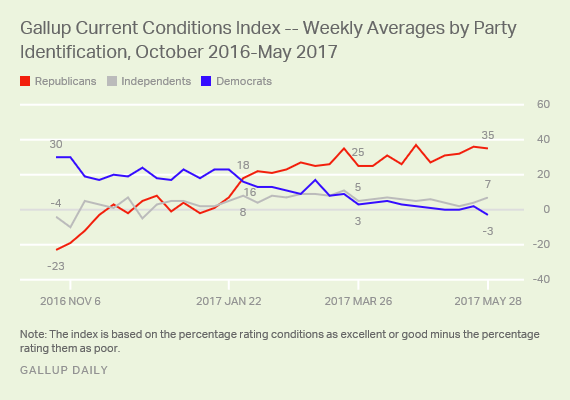
On the economic outlook dimension, Republican optimism surpassed Democratic optimism right after Trump was elected. Republicans continued to grow more likely to say the economy was getting better during the presidential transition period, while Democrats' views held steady. From mid-November through mid-January, roughly equal percentages of Democrats said the economy was getting better as said it was getting worse.
The parties' views diverged further just after Trump's inauguration, with Democrats' outlook score sliding into solidly negative territory and Republicans' score getting an additional boost. Republicans' views have changed little over the past four months, while Democrats have grown increasingly pessimistic about the economy's direction.
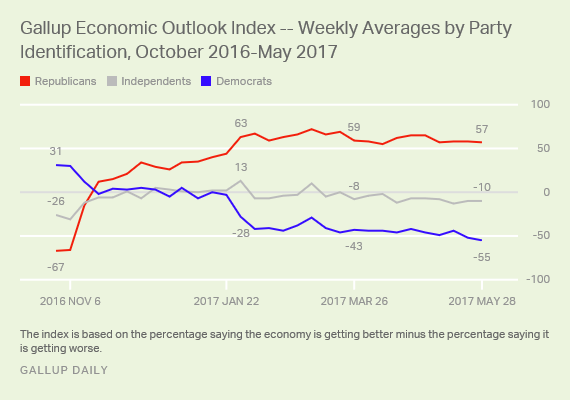
Bottom Line
Four months into Trump's administration, many aspects of the economy are the same as or similar to what they were in the final months of Obama's presidency. Unemployment remains low, the economy is growing (albeit at a sluggish pace), and gasoline is relatively inexpensive. One thing that has changed since Trump's election is stock values, which have reached record highs this year.
Regardless of what is happening in the economy, the data indicate that individuals' views of the economy depend strongly on the party of the president. Partisans' evaluations of the economy change when new presidents are elected, when they take office and in their first months on the job.
However, Americans' evaluations of the economy are more than a simple reflection of their partisanship. In the aggregate, economic confidence measures vary over time when there is no change in the party of the president. These changes usually occur in response to news about the health of the economy or key events that have implications for the economy, such as the downgrading of the United States' credit rating in 2011, the partial federal government shutdown in 2013 and the sustained drop in gas prices in late 2014 and early 2015. Even though large partisan gaps in ratings of the economy persisted during these times, both party groups' evaluations of the economy moved in the same direction in response to these events.
Economic confidence peaked in March 2017, with Gallup's index hitting a post-recession high of +16 around the time the Dow Jones industrial average surpassed 21,000 for the first time. Confidence has come down since, with the decline occurring mostly among Democrats. Republicans' confidence has been steady since Trump assumed office. Democrats have become increasingly pessimistic about both current economic conditions and the economy's outlook. They may continue to grow more pessimistic as the nation moves further away in time from the Obama administration and the economy becomes increasingly Trump's and less Obama's.
These data are available in Gallup Analytics.
Gallup.com reports results from these indexes in daily, weekly and monthly averages and in Gallup.com stories. Complete trend data are always available to view in the following charts:
Daily: Employment, Economic Confidence, Consumer Spending
Weekly: Employment, Economic Confidence, Job Creation, Consumer Spending
Read more about Gallup's economic measures.
View our economic release schedule.
Survey Methods
Results for this Gallup poll are based on telephone interviews conducted May 22-28, 2017, with a random sample of 3,524 adults, aged 18 and older, living in all 50 U.S. states and the District of Columbia. For results based on the total sample of national adults, the margin of sampling error is ±2 percentage points at the 95% confidence level.
For results based on the samples of 1,054 Democrats and 995 Republicans, the margin of sampling error is ±4 percentage points at the 95% confidence level.
For results based on the sample of 1,333 independents, the margin of sampling error is ±3 percentage points at the 95% confidence level.
All reported margins of sampling error include computed design effects for weighting.
Each sample of national adults includes a minimum quota of 70% cellphone respondents and 30% landline respondents, with additional minimum quotas by time zone within region. Landline and cellular telephone numbers are selected using random-digit-dial methods.
Learn more about how the Gallup U.S. Daily works.
